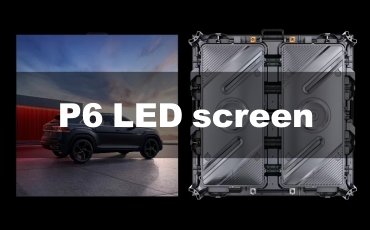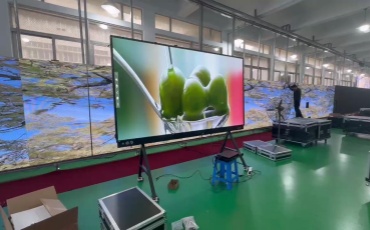1. Calculation method of dot spacing:
The center distance between each pixel and each adjacent pixel;
Each pixel can be one LED light [such as: PH10 (1R)],
Two LED lights [such as: PH16 (2R)], three LED lights [such as: PH16 (2R1G1B)],
The dot spacing of P16 is: 16MM; The dot spacing of P20 is: 20MM; The dot spacing of P12 is: 12MM
2. Calculation method of length and height
Dot spacing × number of dots = length/height
For example:
PH16 length = 16 dots × 1.6㎝ = 25.6㎝ height = 8 dots × 1.6㎝ = 12.8㎝
PH10 length = 32 dots × 1.0㎝ = 32㎝ height = 16 dots × 1.0㎝ = 16㎝;
3. Calculation method of the number of modules used in the screen
Total area ÷ module length ÷ module height = number of modules used
For example:
the number of modules used in a 10 square meter PH16 outdoor monochrome LED display is equal to:
10 square meters ÷ 0.256 meters ÷ 0.128 meters = 305.17678≈305
More accurate calculation method: the number of modules used in length × the number of modules used in height = the total number of modules used
For example:
the number of modules used in a 5 meter long and 2 meter high PH16 monochrome LED display:
The number of modules used in length = 5 meters ÷ 0.256 meters = 19.53125≈20
The number of modules used in height = 2 meters ÷ 0.128 meters = 15.625≈16
Total number of modules used = 20 × 16 = 320
4. Calculation method of visible distance of LED display
RGB color mixing distance The distance at which three colors are mixed into a single color:
LED full-color screen viewing distance = pixel pitch (mm) × 500/1000
The minimum viewing distance that can display a smooth image:
LED display viewing distance = pixel pitch (mm) × 1000/1000
The most suitable viewing distance The distance at which the viewer can see a highly clear picture:
LED display optimal viewing distance = pixel pitch (mm) × 3000/1000
The farthest viewing distance:
LED display farthest viewing distance = screen height (meters) × 30 (times)
5. Calculation method of LED display scanning method
Scanning method: In a certain display area, the ratio of the number of rows lit at the same time to the number of rows in the entire area.
Indoor single and double colors are generally 1/16 scanning,
Indoor full color is generally 1/8 scanning,
Outdoor single and double colors are generally 1/4 scanning,
Outdoor full color is generally static scanning.
At present, there are two driving modes of LED display screens on the market: static scanning and dynamic scanning.
Static scanning is divided into static real pixels and static virtual, and dynamic scanning is also divided into dynamic real images and dynamic virtual;
driving devices generally use domestic HC595, Taiwan MBI5026, and Japan Toshiba TB62726, which generally have 1/2 scanning, 1/4 scanning, 1/8 scanning, and 1/16 scanning.
For example:
A commonly used full-color module has 16*8 pixels (2R1G1B). If it is driven by MBI5026, the total number of pixels used by the module is:
16*8*(2+1+1)=512. MBI5026 is a 16-bit chip, 512/16=32
(1) If 32 MBI5026 chips are used, it is static virtual
(2) If 16 MBI5026 chips are used, it is dynamic 1/2 scan virtual
(3) If 8 MBI5026 chips are used, it is dynamic 1/4 scan virtual
If two red lights on the board are connected in series
(4) Using 24 MBI5026 chips, it is a static real pixel
(5) Using 12 MBI5026 chips, it is a dynamic 1/2 scan real pixel
(6) Using 6 MBI5026 chips, it is a dynamic 1/4 scan real pixel
In the LED unit board, the scanning modes are 1/16, 1/8, 1/4, 1/2, and static.
How to distinguish?
The simplest way is to count the number of LEDs and the number of 74HC595s in the unit board.
Calculation method:
the number of LEDs divided by the number of 74HC595s divided by 8 = fractional scan
Real pixels and virtual pixels are corresponding: Simply put,
Real pixel screen means that each of the three red, green and blue light-emitting tubes that constitute the display screen ultimately participates in the imaging of only one pixel to obtain sufficient brightness.
Virtual pixels use software algorithms to control the light-emitting tubes of each color to eventually participate in the imaging of multiple adjacent pixels,
so that a larger resolution can be achieved with fewer tubes, which can increase the display resolution by four times.
6. Calculation method of the number of power supplies for LED display screens
The power supplies are 30A and 40A; for single-color, 8 unit boards need 1 40A power supply, and for double-color, 6 unit boards need 1 power supply;
For full-color unit boards, calculate based on the maximum power when fully lit.
a. The number of unit boards that a power supply can carry = power supply voltage * power supply current / horizontal pixel number of unit board / vertical pixel number of unit board / 0.1 / 2
For example:
semi-outdoor P10: 5V40A power supply can carry: 5*40/(32*16*0.1/0.5) = 7.8, take the larger 8;
b. According to the total power of the screen, the number of power supplies required = average total power / power of a power supply (power supply voltage * power supply current)
For example:
a strip screen uses 12 P10 modules for the length and 3 P10 modules for the height, a total of: 36 modules, then the number of power supplies required = 32*16*0.1*36*0.5/5/40=4.6, take the larger (5 power supplies)
7. LED display power calculation method
The power formula is P=UI
P stands for power, U stands for voltage, and I stands for current.
Usually, the power supply voltage we use is 5V, and the power supply is 30A and 40A;
the single color is 8 unit boards and 1 40A power supply, and the double color is 6 unit boards and 1 power supply;
the power of the outdoor screen can be found in the “Product Parameters” on the website, which is very clear.
The following is an example
A unit wants to make a 9 square meter indoor 5.0 double color electronic screen, and calculate the maximum power required.
First, calculate the number of 40A power supplies = 9 (0.244*0.488)/6=12.5=13 power supplies (must be integers, with the larger one as the standard).
Then it is very simple, the maximum power P=13*40A*5V=2600W.
The power of a single lamp = 5V*20mA = 0.1W
The power of the LED display unit board = the power of a single lamp * resolution (horizontal pixel number * vertical pixel number) / 2
The maximum power of the screen = the resolution of the screen * the number of lamps per resolution * 0.1
The average power of the screen = the resolution of the screen * the number of lamps per resolution * 0.1/2
The actual power of the screen = the resolution of the screen * the number of lamps per resolution * 0.1/number of scans (4 scans, 2 scans, 16 scans, 8 scans, static)
8. Calculation method of LED display brightness
Brightness: The overall brightness of the screen is integrated by the brightness of a single lamp.
For example:
3906-dot P16 outdoor full-color screen 2R1PG1B (1/4 scan), Dalian Lumei tube core, the red tube brightness is 800mcd, the green tube brightness is 2300mcd, and the blue tube brightness is 350mcd.
From this, the theoretical brightness of a square can be calculated as (800*2+2300+350)*3906/1000/4=4150cd
How to calculate the brightness of a single tube under the conditions of clear brightness and dot density requirements?
The calculation method is as follows: (taking two red, one green and one blue as an example)
Red LED brightness: brightness (CD)/M2÷number of dots/M2×0.3÷2
Green LED brightness: brightness (CD)/M2÷number of dots/M2×0.6
Blue LED brightness: brightness (CD)/M2÷number of dots/M2×0.1
For example:
2500 dots per square meter, 2R1G1B, brightness requirement per square meter is 5000 CD/M2, then:
Red LED brightness: 5000÷2500×0.3÷2=0.3
Green LED brightness: 5000÷2500×0.6÷2=1.2
Blue LED brightness: 5000÷2500×0.1=0.2
Brightness of each pixel: 0.3×2+1.2+0.2=2.0 CD
9. Calculation method of LED display resolution
LED display resolution per square = 1/pixel spacing (unitized as M)/pixel spacing (unitized as M) For example: P16 resolution per square = 1/0.016/0.016 = 3906 DOT (dots)
10. The viewing angle of the LED display depends on the selected LED lamp beads
Such as indoor surface mount lamp: SMD0603/0805: H: 160 degrees V: 120 degrees
SMD3528 viewing angle: H: 140 degrees V: 120 degrees
Outdoor plug-in lamp DIP: dip346/546: H: 110 degrees V: 50 degrees
LED wavelength range:
Red: 625-630nm
Yellow-green: 568-572nm
Pure green: 520-530nm
Blue: 460-470nm
Yellow: 585-590nm led display calculation method | led electronic display power calculation | led power calculation method
General brightness requirements are as follows:
(1) Indoor: >800CD/M2
(2) Semi-indoor: >2000CD/M2
(3) Outdoor (facing south): >4000CD/M2
(4) Outdoor (facing north): >8000CD/M2
11. What are the brightness requirements for red, green and blue in white?
Red, green and blue contribute differently to the color of white.
The fundamental reason is that the retina of the human eye has different perceptions of light of different wavelengths.
After a large number of experimental tests, the following approximate ratios are obtained for reference
Design:
Simple red, green and blue brightness ratio: 3:6:1
Accurate red, green and blue brightness ratio: 3.0:5.9:1.1
What is the general length-to-width ratio of the display?
Graphic screen: Determined according to the displayed content;
Video screen: Generally 4:3 or close to 4:3; the ideal ratio is 16:9.
12. What are the installation requirements for the display screen?
Power supply requirements:
The power supply connection point should be within the size of the screen
220V mains power supply, live wire, neutral wire and ground wire;
380V mains power supply, three live wires and one neutral wire and ground wire;
Display screens above kilowatts should be equipped with step-down starting equipment.
Communication requirements:
The communication distance is defined by the length of the communication line.
Communication line should be installed according to the communication line length standard used by the model of the installed display screen.
The communication line is prohibited from running in the same wire tube as the power line.
Installation requirements:
The display screen should be installed horizontally from left to right, and backward tilting is not allowed
Up and down adjustment rods should be installed for hoisting
Forward tilting hooks should be installed before wall-mounted installation
Location support bolts should be added for floor-mounted installation.




